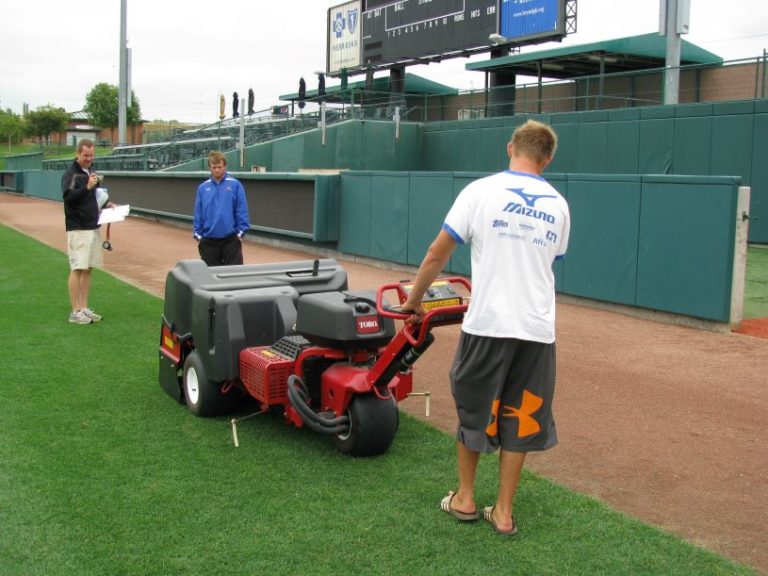By John C. Fech and Brad Jakubowski
If there’s one thing that all sports field managers utilize on a regular basis, it’s aeration. Of course, there are a lot of considerations, techniques and timing issues to contemplate for each field. It could be said that everyone does it – it’s just a matter of how and when, and which other practices might be involved.
With any procedure that is done to or for sports turf, it’s always wise to ask why. After all, doing something just to be doing it is akin to recreational tillage for row crop farmers or planting radishes in the family veggie garden. If the soil is already in good shape for soybeans and if no one in the family likes the taste of radishes, then it’s a waste of time and money. However, if there are good reasons, then these activities make good sense; it’s much the same with aeration.
So, why aerate? The common-sense answer is, “for many reasons.” The most prominent reason is to reduce compaction, defined as the reduction of air spaces in the soil as a result of mechanical force(s). Heavily trafficked, highly compacted fields greatly benefit from regular efforts that rearrange and open soil particles that have been pressed together.
In addition to compaction reduction, aerification processes enhance root growth. When cut through coring, slicing or spiking, roots are severed. If they are healthy when this occurs, the common response is a corresponding expansion of root volume – a root pruning of sorts that resembles the result of pruning a hedge or topping a tree. While tree topping is a poor arboricultural practice, root pruning normally results in greater capacity to absorb nutrients and water and resist wear.
Once soil voids are enlarged, oxygen penetration into the soil increases, as does the potential for infiltration of applied fertilizer, insecticides, fungicides and turf seed. Aeration is a great first step in the control of pests, as well as increasing turf plant density. A lesser, but still valuable, benefit from core cultivation aeration is the slowing of thatch accumulation as the result of soil microorganisms being introduced once cores are brought to the surface and shattered, allowing small particles to filter downward into the thatch.
Pitfalls/drawbacks
Nothing comes for free. Unfortunately, there are certain negative consequences with aeration practices. By managing how and when aeration is performed, these can be kept to a minimum. What are they? First, the disruption in play. If you’ve ever had a coach or player complain that their uniform or shoes were muddy after practice or a game, it’s probably due to the consequences of aeration. To the greatest extent possible, sports play should be delayed until a field has adequate time to recover following aeration.
Next, aeration causes damage to existing turf plants – particularly roots and crowns. As noted, roots generally regrow; however, crowns are usually removed permanently, and must be replaced through reseeding or rhizome/stolon regrowth. Depending on the field location, perhaps the biggest cost is the price of the equipment itself and the amount necessary to hire and retain qualified employees to run it properly. Considering today’s labor market, these are drawbacks indeed.
General aeration principles
Given that aeration is a foundational sports field management practice, it’s helpful to consider some general principles, especially when fine-tuning implementation on a specific field. Some important dynamics to think through are as follows:
- Soils with high clay and silt content are most prone to compaction, especially when exposed to traffic following irrigation or rainfall events. Fields built on clay may be good candidates for long-term soil amendment with compost.
- Soil compaction reduces turf quality, growth and vigor by decreasing the size of the air spaces between soil particles, which results in reduced water infiltration and root growth. Though it may be difficult for administrators to understand, the benefits of other essential practices such as fertilization, pest control, striping, seeding and mowing will be greatly reduced if compaction is not managed well.
- Compaction is greatest in the upper 1 to 2 inches of the soil profile. Frequent efforts to relieve compaction in this zone pay dividends. Occasional deep tine cultivation may also be necessary, depending on soil type and field traffic.
- Sites prone to compaction should be aerified frequently. Although each part of a field is important, not all are equal in terms of traffic and other influences of compaction. Each field should be examined for site-specific levels of compaction (i.e., end zones, between hashmarks, goal mouth, etc.). It’s likely that some areas will need aerification more frequently than others.
- Aerification should be done when the turf is actively growing and has the potential for recovery and to maximize the root expansion/root growth response. After all, a small amount of damage is done by disturbing the soil/thatch/plant crown interface. Grass species and field use greatly affect timing. For example, early to mid-spring and early fall are ideal for cool-season species such as Kentucky bluegrass, while early summer is good timing for bermudagrass.
- When soils are moist from rainfall events, timing is greatly influenced; aerification operations in overly wet soils sometimes result in increased, not decreased compaction. Similarly, when soils are on the dry side, aerification practices are hard to implement. The sweet spot comes with experience, but suffice it to say, the end result is probably the best answer. If the cores that are pulled out of a field are 3 inches long and full of roots, then the soil moisture is ideal.
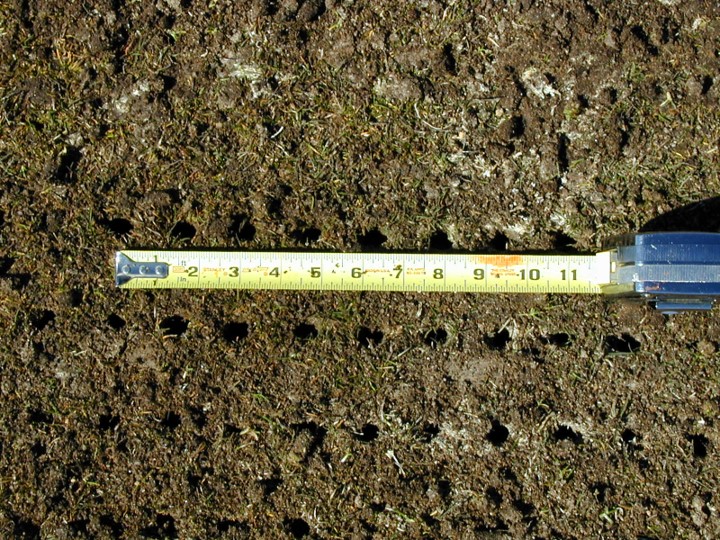
- The number of holes per square foot is a debatable topic. A standard goal of most aeration procedures is 36 holes per sq. ft. (or a 2-inch-by-2-inch spacing), but may or may not be feasible due to the type of equipment that is available to you or the time it takes to run the machine over the field and the time available for recovery. If one keeps in mind that even at 36 holes per sq. ft., less than 5 percent of the field is being affected by the aerification process, the more holes you can “punch,” the better. Normally, to get the higher hole count, an aerifier that mechanically drives the tines is required.
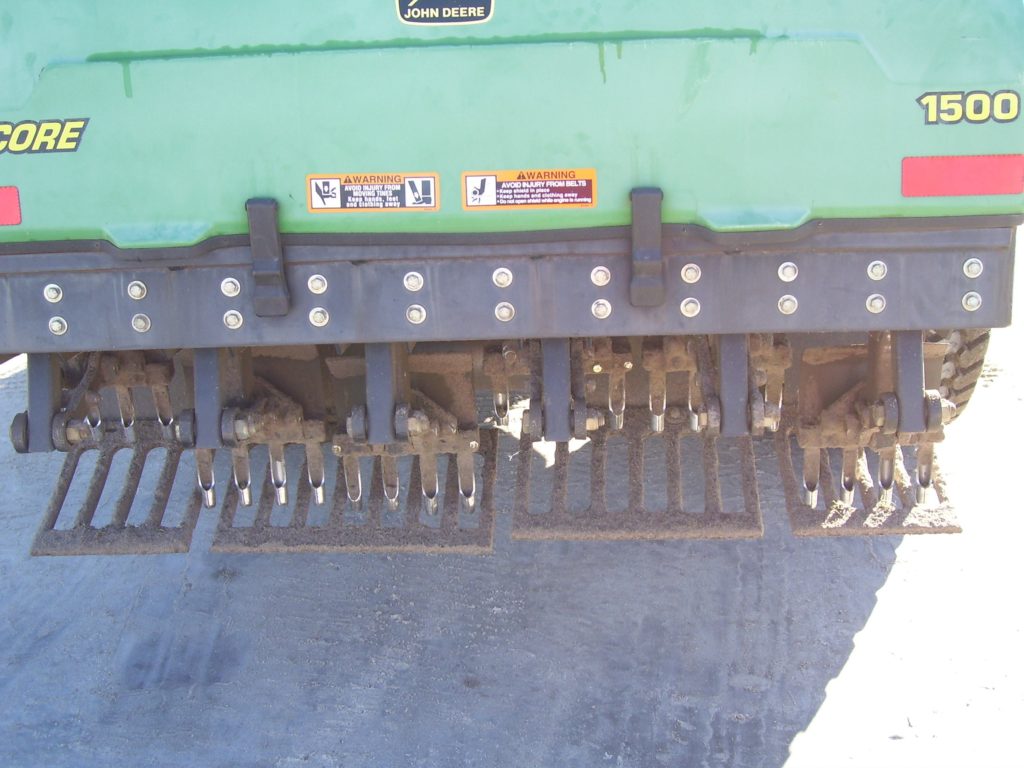
Aerifiers that utilize the weight of the machine and gravity (often referred to as drum-type) normally have spoon-type tines and provide a much wider tine spacing than a mechanically driven aerifier.
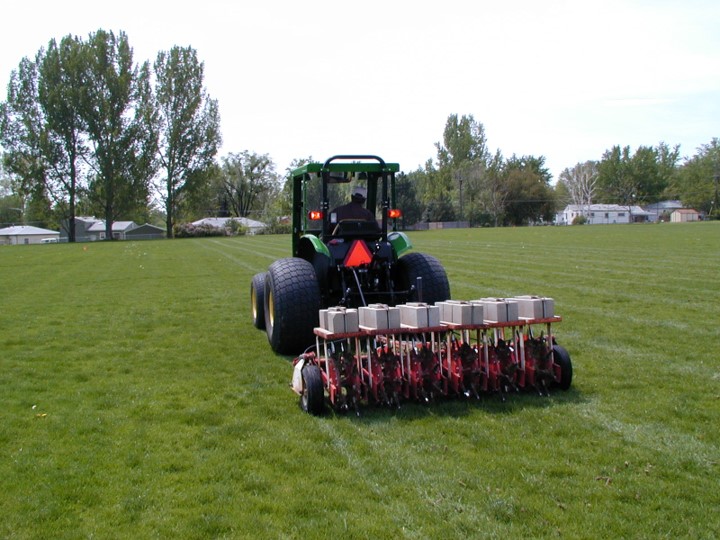
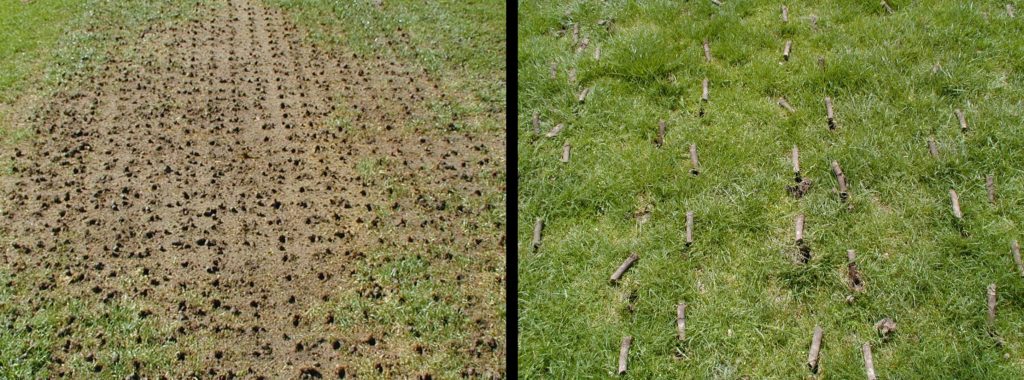
The differences are noticeable when comparing the two as in the side-by-side image. For a drum -type aerifier (right) to equal the hole count of a mechanically driven aerifier (left), aerification needs to be repeated 4 to 8 times.
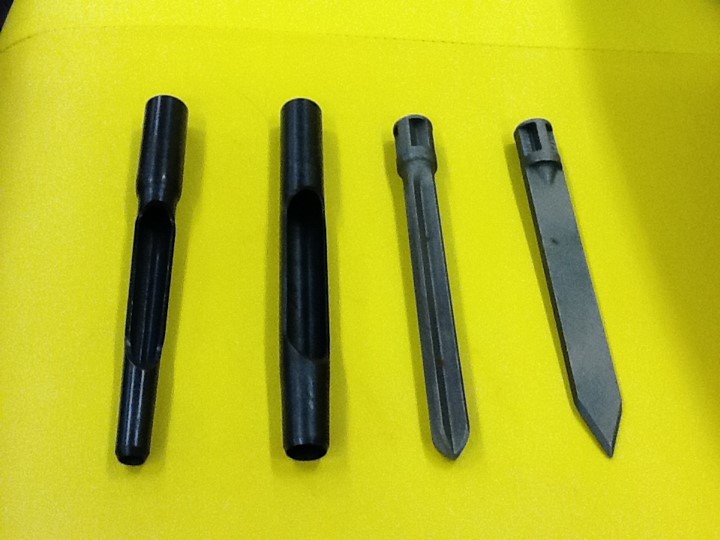
- Another popular question is, “Which type of tines do we use, hollow or solid?” Rules of thumb for each are as follows.
Use Hollow Tines
- During periods of healthy growth
- 30 days prior to high-stress periods of cold or heat
- When soils are moist
- Use as large of tines as you can tolerate
Use Solid Tines
- During periods of more stressful conditions
- Bayonet or slicer tines during the most stressful periods
- When soils are drier
- As often as you or your turfgrass can tolerate
To minimize disruption of fields during critical use or stress periods, slicing or spinking tines can be used. Some refer to this operation as venting. The drawback of slicing or spiking is that compaction relief is minimal, but it does aid in vertical air and water movement into the rootzone. This process can be used on native or sand-based rootzones.
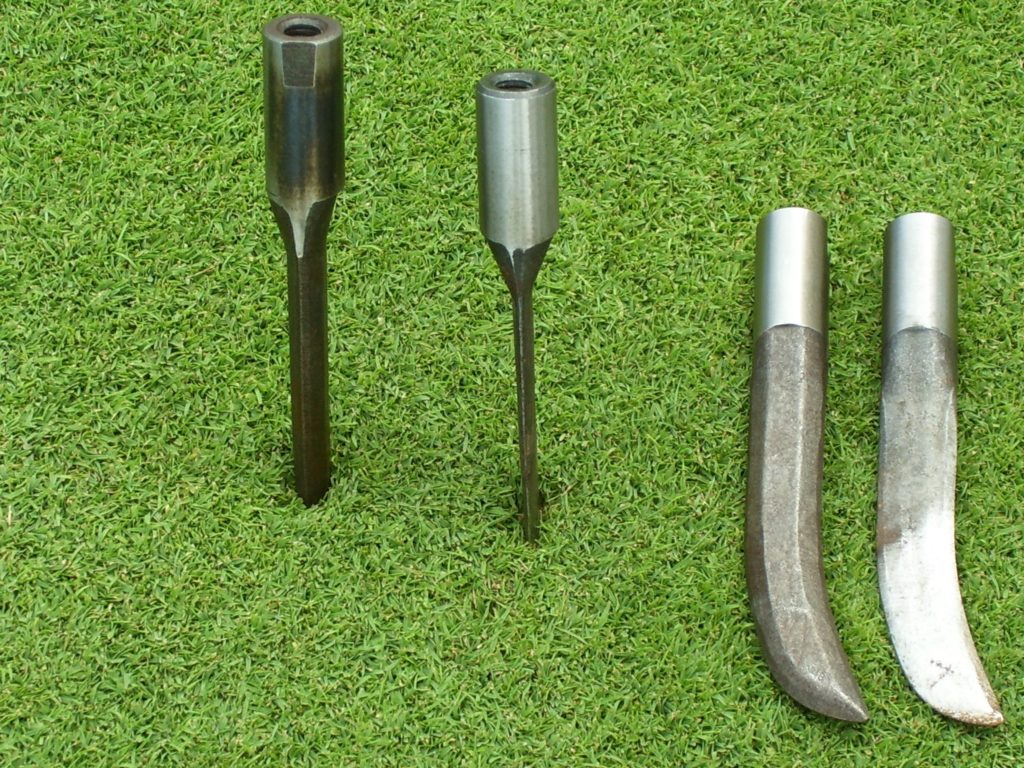
If you are suffering from extremely dry and hard playing surfaces, deep-tine aerifiers (using solid tines) insert tines into the soil vertically then have a lateral, kick-back action that helps fracture the soil and will alleviate surface and deeper compaction problems and help improve water movement into previously relatively impervious soils.
Vibratory aerifiers can provide a combination of compaction relief and venting near the surface without a lot of playing surface disruption. Seeders are often combined with these machines to provide an effective turfgrass establishment tool.
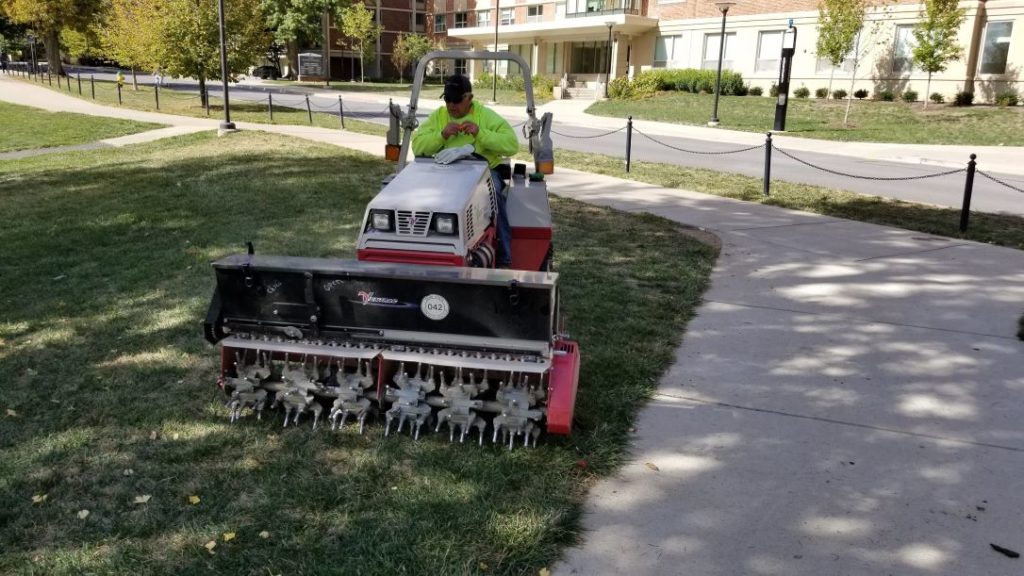
There are many alternative technologies available as well. Many of these processes create aerification holes and then immediately fill the holes with various rootzone materials including sand and calcined clay products. Some technologies also use pressurized air or water to help fracture the rootzone. Air injection is normally more effective in native soils because the rootzone soils will more likely be fractured. With sand-based root zones, the materials may only be redistributed and the effect more temporary. Water injection is particularly beneficial when some kind of aerification in needed but the fields require minimum disruption, as during a multi-game homestand. Plus, it provides some water directly to the rootzone.
In addition to aerification, there are several other methods to reduce compaction and therefore reduce the need to aerify. Traffic control (rotating fields, restricting practice sessions, etc.) is very impactful and should be negotiated as part of the overall field management plan. Topdressing following aerification may reduce the total number of aerification passes over a field in a given year. In any of these situations, the denser the turfgrass cover, the better your surface will be able to tolerate or resist compaction and other degrading effects.
To provide better overall establishment of overseeded grasses, consider multilevel cultivation while applying seed. This strategy provides grasses the opportunity to establish and grow from multiple starting points, hence improving its chance of surviving and providing a sustainable playing surface.
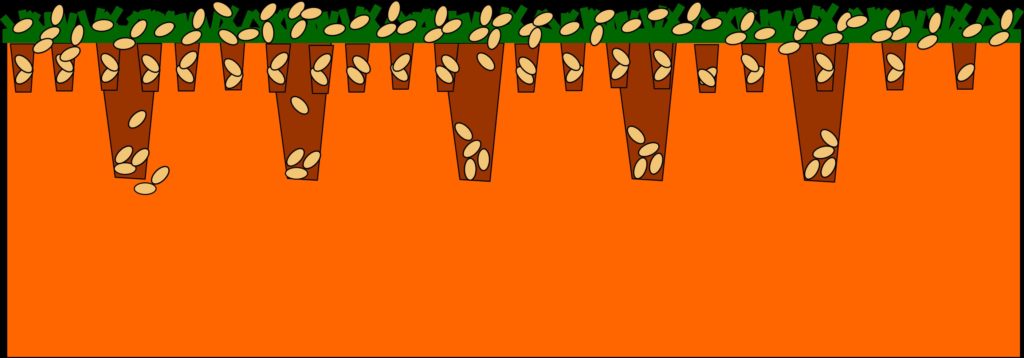
Regardless of the methods or technologies you employ to aerify your playing surfaces, anything that you do will help you to better succeed in providing safe and playable surfaces. The key is to keep showing up and to be as consistent with your cultivation practices as possible. Increasing what you do by a mere 10 to 20 percent could make a huge difference throughout the year. Good luck, and keep plugging away!
John C. Fech is a horticulturist with the University of Nebraska-Lincoln and certified arborist with the International Society of Arboriculture. The author of two books and more than 400 popular and trade journal articles, he focuses his time on teaching effective landscape maintenance techniques, water conservation, diagnosing turf and ornamental problems, and encouraging effective bilingual communication in the green industry.
Brad Jakubowski is a turfgrass and irrigation instructor with Penn State University. He is a certified irrigation technician with the Irrigation Association and is an author and presenter covering multiple management areas within the turfgrass industry. He focuses his time on teaching best irrigation practices and troubleshooting, weather-based management decisions, soils and plant nutrition.

